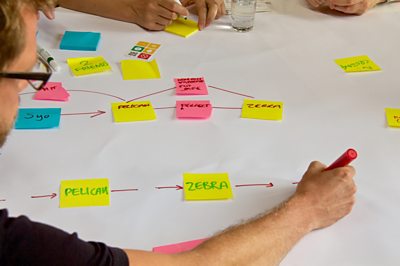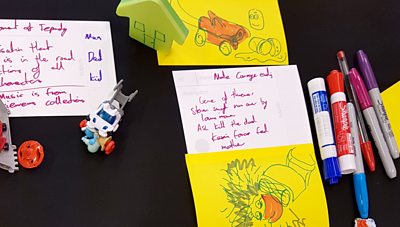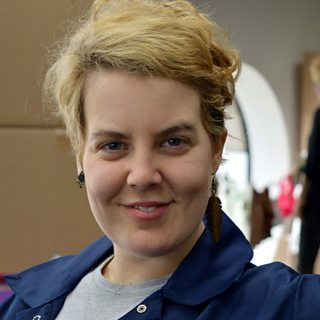
We're getting early insight on the workflow processes required for making personalised interactive media at scale. Using paper and pens to understand the mechanics of planning relationships between pieces of object-based media.
The workshops were focussed on ideation of non-linear or variable narratives, imagined as drama, learning, or news experiences. The aim for workshop participants was to consider how they might express their story with diagrams, drawings, and text to illustrate all possible (and desirable) variance or adaptation; and how they would write rules to let an audience experience the most appropriate path through that story.
Stage one was for small teams of 5 to create a simple story, initiated by opening a chocolate containing a toy surprise. The toys were intended to inspire characters, events, and locations for their story. This chance element made it fun and meant the members of the team were more invested in their story rather than an example one we'd given them, because they had built it together.
We asked them to fill out a simple form to organise their devisded plot into a traditional three-act framework with a beginning, middle, & end - as a concise summary, before evolving these simple chunks into more meaningful scenes within their story.
We then asked teams to think about how they might present parts of their story differently for different audience members, based on a person's context. For example - where they live, how old they are, or how they had interacted with other parts of the experience.
People organised their story elements by using post-its, and big sheets of paper. We came prepared with a set of story cards we had designed to allow people to easily lay out "blocks" of their narratives, and plot how they connect to each other. Input and output conditions could also be mapped on the cards, to map rules for how someone might experience a pathway through the story.
We gave groups a large amount of space, and most teams scripted their story plans using mapping conventions, either as graphs or blocks of content within columns.
One team were inspired to make a racing drama, where the forest scenery and race tracks depicted would be rendered to dynamically reflect the time of day synchronised with the audience at home, by having the race-track floodlit if it’s night.
Another chose to apply variations to coverage of an accident in a news programme, based on the age of the viewer. This story could be authored for both pre & post-watershed audiences at the same time, with media marked-up to flag grizzly details and graphic language which would be removed automatically for a younger viewer on play-out.
A third prototype story was an interactive learning experience, where you face various learning challenges accompanied by a grasshopper revision buddy. How well you do at each challenge influences subsequent parts of the programme.

Feedback from workshop participants was incredibly positive, and we hope to engage internal teams and external practitioners in further potential collaborative work and productions. The outputs of the workshops will inform how we progress reccomendations for the creation process for OBM. We're now planning improved and evolved workshops to test and iterate the design of our embryonic software tools, dates and details for these will appear on the Object-Based Media Toolkit project page.
- Tweet This - Share on Facebook
- BBC R&D - Object-Based Media
- BBC R&D - Object-Based Media Toolkit
- BBC R&D - Object-Based Media on the Road - Discover for Yourself
- BBC R&D - Our Vision of the Future
- The Next Web - How the BBC is building the future of broadcasting by blowing it up into little bits
- BBC R&D - Cook Along Kitchen Experience
- BBC R&D - Visual Perceptive Media
- BBC R&D - Story Explorer
- BBC R&D - Newsbeat Explains
-

Future Experience Technologies section
This project is part of the Future Experience Technologies section

